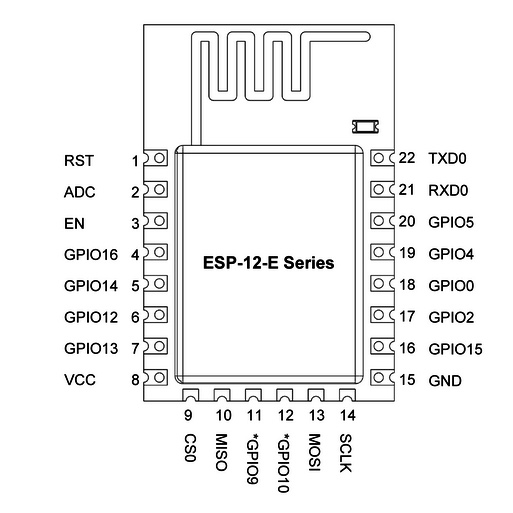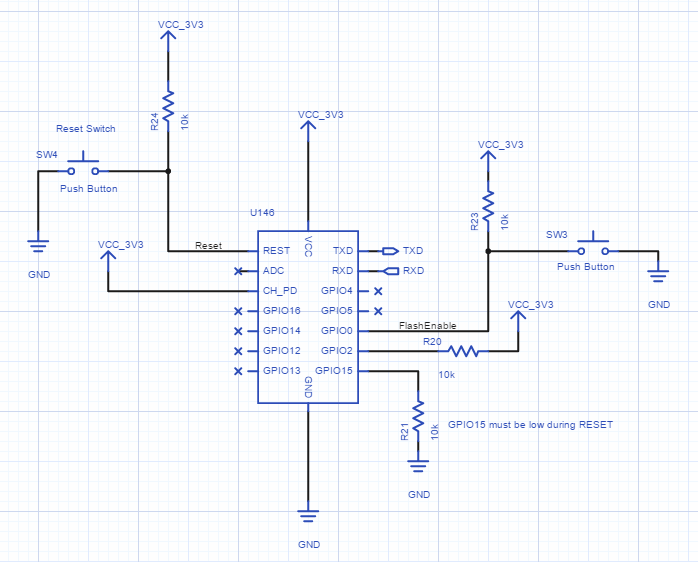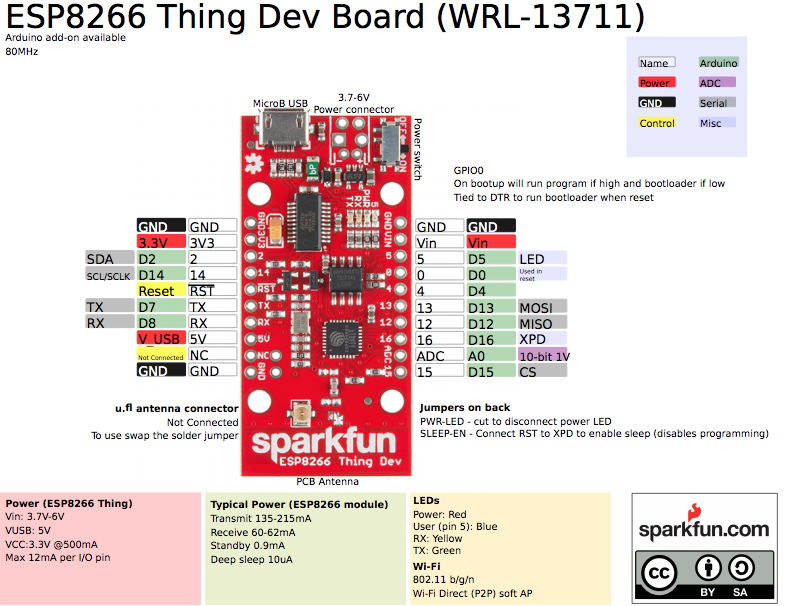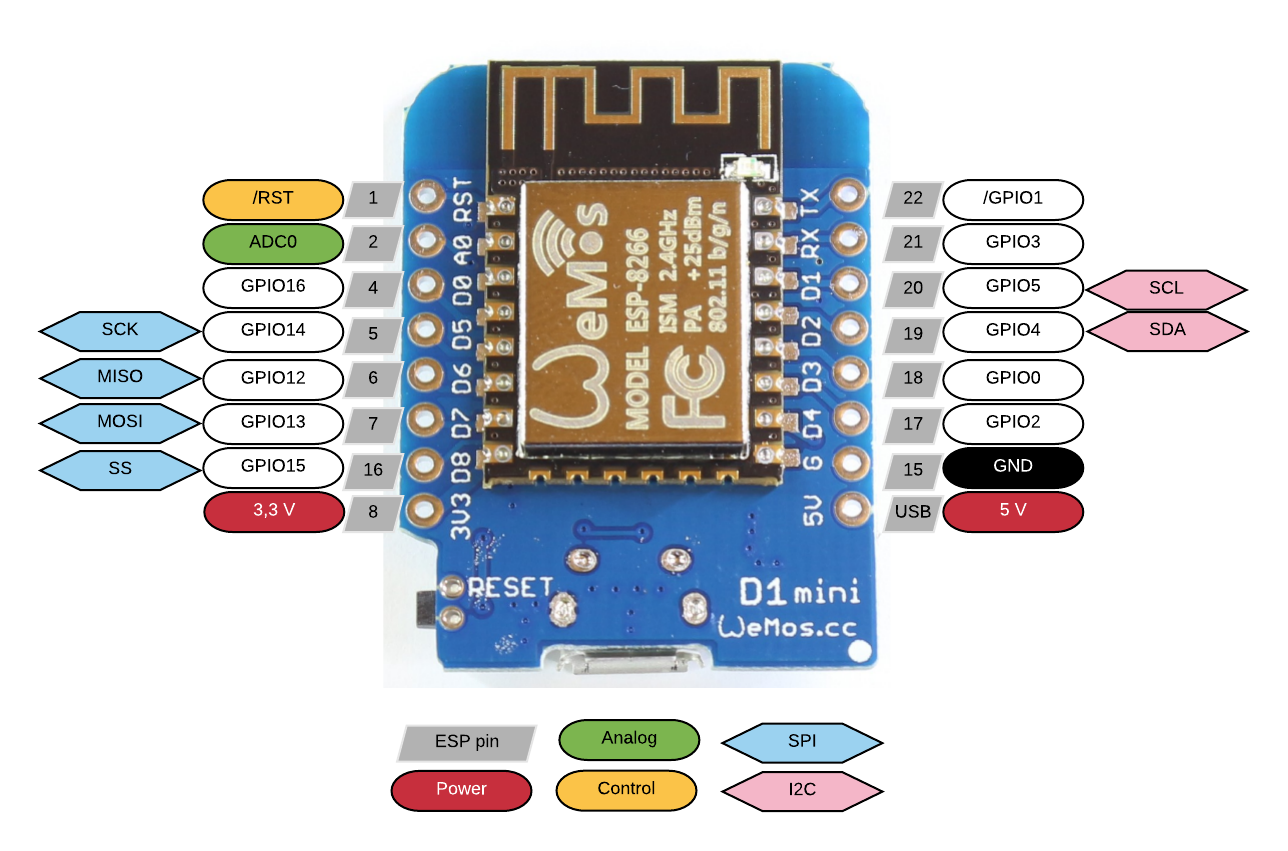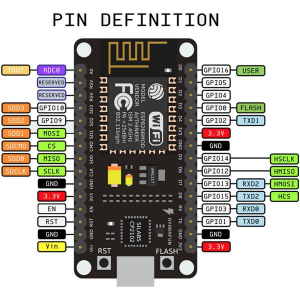ESp8266 ESP-12-E
The ESP-12E has a ESP8266 core processor, with a module of 4MB of flash memory. Also it has 22 pins and a on board printed antenna. It also has a built-in LED which is directly connected to the UART TX line. You can use the TX pin as GPIO1 to control the LED, but only if you don't use UART.
Pins
| Pin | Description |
|---|---|
| RST | External Reset - Low=RESET, High=NORMAL |
| ADC | Analog DIgital Converter - Max Voltage = 1V |
| EN | Chip Enable - Low=DISABLED, High=NORMAL |
| GPIO16 | GPIO16 |
| GPIO14 | GPIO14, CLK(SPI) |
| GPIO12 | GPIO12, MISO(SPI) |
| GPIO13 | GPIO13, MOSI(SPI) |
| VCC | 3.3V |
| TX0/GPIO1 | TX0, GPIO1 |
| RX0/GPIO3 | RX0, GPIO3 |
| GPIO5 | GPIO5 |
| GPIO4 | GPIO4 |
| GPIO0 | GPIO0, HIGH on boot |
| GPIO2 | GPIO2, HIGH on boot |
| GPIO15 | GPIO15, LOW on boot |
| GND | Ground |
ESP8266 Bootloader Modes
The bootloader can go into a number of modes depending on the state of GPIOs 0, 2 and 15. The two useful modes are the UART download mode (for flashing new firmware) and the flash startup mode (which boots from flash).
| Mode | GPIO0 | GPIO2 | GPIO15 |
|---|---|---|---|
| UART Download Mode (Programming) | 0 | 1 | 0 |
| Flash Startup (Normal) | 1 | 1 | 0 |
| SD-Card Boot | 0 | 0 | 1 |
CH_PD (or EN) Chip enable. Should be high for normal operation.
Wiring the ESP8266 Chip
Details
| Spefication | |
|---|---|
| GPIO Output Current | 12 mA |
Dev Boards
| Board | Info | Layout |
|---|---|---|
ESP8266 Thing Dev | https://www.sparkfun.com/products/13711 PROS: External antenna connection. Serial Driver: CP2102 Cost: $15 US Schematic: https://cdn.sparkfun.com/datasheets/Wireless/WiFi/ESP8266-Thing-Dev-v10.pdf | |
| WeMos D1 Mini | https://wiki.wemos.cc/products:d1:d1_mini PROS: Shields available, ADC has voltage divider to support 3.3v input. Serial Driver: CH34x Cost: $3.25 US Schematic: https://wiki.wemos.cc/_media/products:d1:sch_d1_mini_v3.0.0.pdf | |
| Node MCU Lolin | https://frightanic.com/iot/comparison-of-esp8266-nodemcu-development-boards/ PROS: Exposes extra pins. Serial Driver: Cost: $3.30 US Schematic: ?? |
References
| Reference | URL |
|---|---|
| ESP-12E | https://github.com/lvidarte/esp8266/wiki/ESP%E2%80%9012E |
ESP8266 Thing Development Board Hookup Guide | https://learn.sparkfun.com/tutorials/esp8266-thing-development-board-hookup-guide/all |
